The Naive Bayes algorithm classifies data points into classes based on probability. It calculates the prior and likelihood probabilities of each feature for each class using the training data. The posterior probabilities are then computed using Bayes' theorem. For a new data point, the algorithm predicts the class with the highest posterior probability. The program implements Naive Bayes by encoding categorical classes numerically, splitting data into training and test sets, computing mean, standard deviation and probabilities for each class, and making predictions on the test set.




![lOMoAR cPSD|37458118
Program:
BFS
graph = {
'5' : ['3','7'],
'3' : ['2', '4'],
'7' : ['8'],
'2' : [],
'4' : ['8'],
'8' : []
}
visited = [] # List for visited nodes.
queue = [] #Initialize a queue
def bfs(visited, graph, node): #function for BFS
visited.append(node)
queue.append(node)
while queue: # Creating loop to visit each node
m = queue.pop(0)
print (m, end = " ")
for neighbour in graph[m]:
if neighbour notin visited:
visited.append(neighbour)
queue.append(neighbour)
# Driver Code
print("Following is the Breadth-First Search")
bfs(visited, graph, '5')
DFS
graph = {
'5' : ['3','7'],
'3' : ['2', '4'],
'7' : ['8'],
'2' : [],
'4' : ['8'],
'8' : []
}
visited = set() # Set to keep track of visited nodes of graph.](https://image.slidesharecdn.com/cs3491-aiandmllabmanual-240329185501-79b0d618/75/CS3491-AI-and-ML-lab-manual-cs3491-r2021-5-2048.jpg)
![lOMoAR cPSD|37458118
defdfs(visited, graph, node): #function for dfs
if node not in visited:
print (node)
visited.add(node)
for neighbour in graph[node]:
dfs(visited, graph, neighbour)
# Driver Code
print("Following is the Depth-First Search")
dfs(visited, graph, '5')](https://image.slidesharecdn.com/cs3491-aiandmllabmanual-240329185501-79b0d618/75/CS3491-AI-and-ML-lab-manual-cs3491-r2021-6-2048.jpg)


![lOMoAR cPSD|37458118
Program:
from queue importPriorityQueue
v =14
graph =[[] fori inrange(v)]
# Function For Implementing Best First Search
# Gives output path having lowest cost
defbest_first_search(actual_Src, target, n):
visited =[False] *n
pq =PriorityQueue()
pq.put((0, actual_Src))
visited[actual_Src] =True
whilepq.empty() ==False:
u =pq.get()[1]
# Displaying the path having lowest cost
print(u, end=" ")
ifu ==target:
break
forv, c ingraph[u]:
ifvisited[v] ==False:
visited[v] =True
pq.put((c, v))
print()
# Function for adding edges to graph
defaddedge(x, y, cost):
graph[x].append((y, cost))
graph[y].append((x, cost))
# The nodes shown in above example(by alphabets) are
# implemented using integers addedge(x,y,cost);
addedge(0, 1, 3)
addedge(0, 2, 6)
addedge(0, 3, 5)
addedge(1, 4, 9)
addedge(1, 5, 8)
addedge(2, 6, 12)
addedge(2, 7, 14)
addedge(3, 8, 7)
addedge(8, 9, 5)
addedge(8, 10, 6)
addedge(9, 11, 1)
addedge(9, 12, 10)
addedge(9, 13, 2)
source =0
target =9
best_first_search(source, target, v)](https://image.slidesharecdn.com/cs3491-aiandmllabmanual-240329185501-79b0d618/75/CS3491-AI-and-ML-lab-manual-cs3491-r2021-9-2048.jpg)
![lOMoAR cPSD|37458118
Memory bounded A*
import numpy as np
import heapq
class Graph:
def __init__(self, adjacency_matrix):
self.adjacency_matrix = adjacency_matrix
self.num_nodes = len(adjacency_matrix)
def get_neighbors(self, node):
return [neighbor for neighbor, is_connected in enumerate(self.adjacency_matrix[node]) if is_connected]
def memory_bounded_a_star(graph, start, goal, memory_limit):
visited = set()
priority_queue = [(0, start)]
memory_usage = 0
while priority_queue:
memory_usage = max(memory_usage, len(visited))
if memory_usage > memory_limit:
print("Memory limit exceeded!")
return None
cost, current_node = heapq.heappop(priority_queue)
if current_node == goal:
print("Goal found!")
return cost
if current_node not in visited:
visited.add(current_node)
for neighbor in graph.get_neighbors(current_node):
heapq.heappush(priority_queue, (cost + 1, neighbor))
print("Goal not reachable!")
return None
if __name__ == "__main__":
# Define the adjacency matrix of the graph
adjacency_matrix = np.array([
[0, 1, 1, 0, 0, 0, 0],
[1, 0, 0, 1, 1, 0, 0],
[1, 0, 0, 0, 0, 1, 0],
[0, 1, 0, 0, 0, 1, 1],
[0, 1, 0, 0, 0, 0, 1],
[0, 0, 1, 1, 0, 0, 1],
[0, 0, 0, 1, 1, 1, 0]
])
graph = Graph(adjacency_matrix)
start_node = 0
goal_node = 6
memory_limit = 10 # Set the memory limit
result = memory_bounded_a_star(graph, start_node, goal_node, memory_limit)
print("Shortest path cost:", result)](https://image.slidesharecdn.com/cs3491-aiandmllabmanual-240329185501-79b0d618/75/CS3491-AI-and-ML-lab-manual-cs3491-r2021-10-2048.jpg)

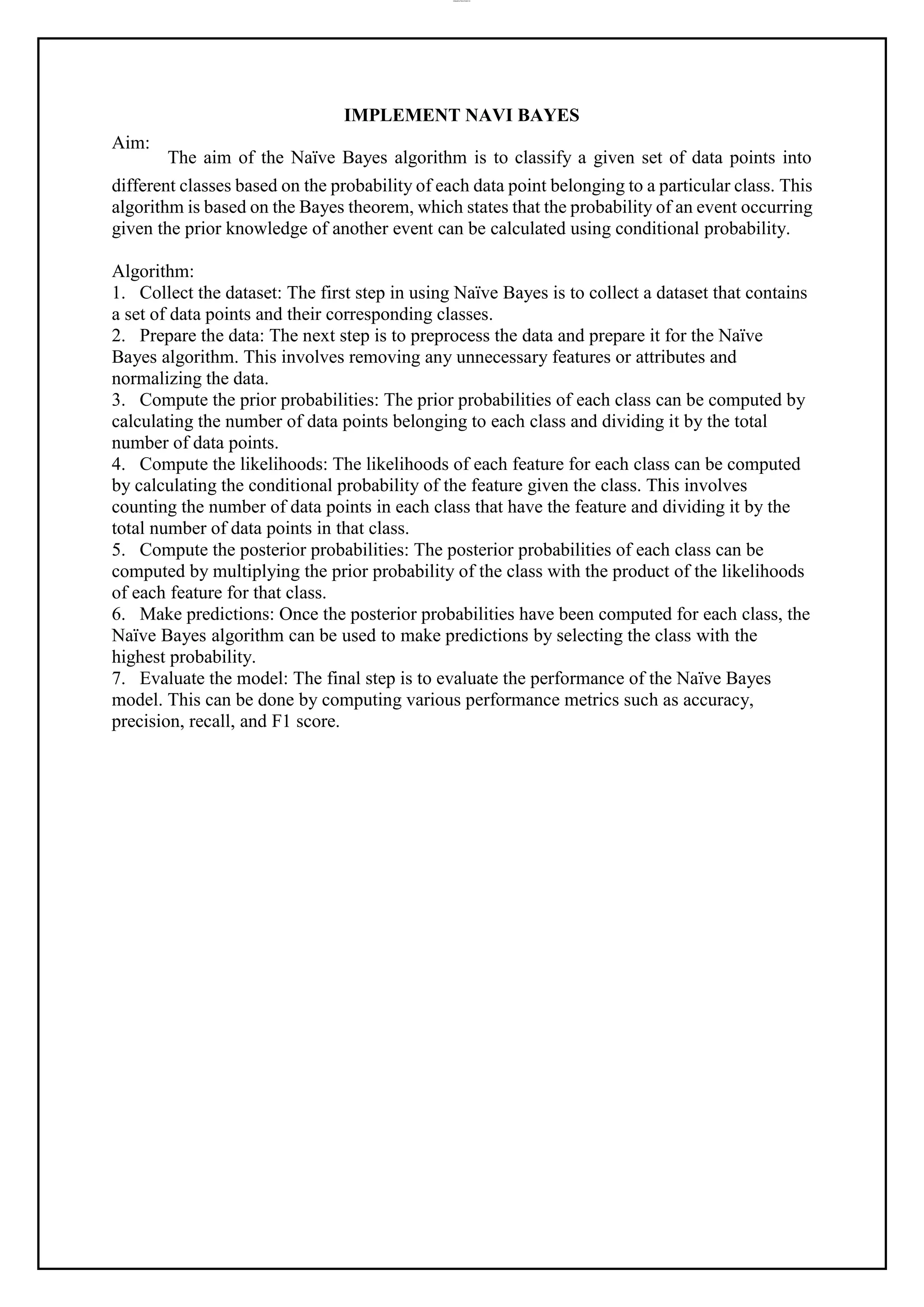
![lOMoAR cPSD|37458118
Program:
# Importing library
import math
import random
import csv
# the categorical class names are changed to numeric data
# eg: yes and no encoded to 1 and 0 def
encode_class(mydata):
classes = []
for i in range(len(mydata)):
ifmydata[i][-1] not in classes:
classes.append(mydata[i][-1])
for i in range(len(classes)):
for j in range(len(mydata)):
if mydata[j][-1] == classes[i]:
mydata[j][-1] = i
return mydata
# Splitting the data
def splitting(mydata, ratio):
train_num = int(len(mydata) * ratio)
train = []
# initiallytestset will have all the dataset
test = list(mydata)
whilelen(train) <train_num:
# index generated randomly from range 0
# to length of testset
index = random.randrange(len(test))
# from testset, pop data rows and put it in train
train.append(test.pop(index))
return train, test
# Group the data rows under each class yes or
# no in dictionary eg: dict[yes] and dict[no]
defgroupUnderClass(mydata):
dict = {}
for i in range(len(mydata)):
if (mydata[i][-1] not in dict):
dict[mydata[i][-1]] = []
dict[mydata[i][-1]].append(mydata[i])
returndict
# Calculating Mean
def mean(numbers):
return sum(numbers) / float(len(numbers))
# Calculating Standard Deviation](https://image.slidesharecdn.com/cs3491-aiandmllabmanual-240329185501-79b0d618/75/CS3491-AI-and-ML-lab-manual-cs3491-r2021-13-2048.jpg)
![lOMoAR cPSD|37458118
defstd_dev(numbers):
avg = mean(numbers)
variance = sum([pow(x - avg, 2) for x in numbers]) / float(len(numbers) - 1)
returnmath.sqrt(variance)
defMeanAndStdDev(mydata):
info = [(mean(attribute), std_dev(attribute)) for attribute in zip(*mydata)]
# eg: list = [ [a, b, c], [m, n, o], [x, y, z]]
# here mean of 1st attribute =(a + m+x), mean of 2nd attribute = (b + n+y)/3
# delete summaries of last class
del info[-1]
return info
# find Mean and Standard Deviation under each class
defMeanAndStdDevForClass(mydata):
info = {}
dict = groupUnderClass(mydata)
forclassValue, instances in dict.items():
info[classValue] = MeanAndStdDev(instances)
return info
# Calculate Gaussian Probability Density Function
defcalculateGaussianProbability(x, mean, stdev):
expo = math.exp(-(math.pow(x - mean, 2) / (2 * math.pow(stdev, 2))))
return (1 / (math.sqrt(2 * math.pi) * stdev)) * expo
# Calculate Class Probabilities
defcalculateClassProbabilities(info, test):
probabilities = {}
forclassValue, classSummaries in info.items():
probabilities[classValue] = 1
for i in range(len(classSummaries)):
mean, std_dev = classSummaries[i]
x = test[i]
probabilities[classValue] *= calculateGaussianProbability(x, mean,
std_dev)
return probabilities
# Make prediction - highest probability is the prediction
def predict(info, test):
probabilities = calculateClassProbabilities(info, test)
bestLabel, bestProb = None, -1
forclassValue, probability in probabilities.items():
ifbestLabel is None or probability >bestProb:
bestProb = probability
bestLabel = classValue
returnbestLabel](https://image.slidesharecdn.com/cs3491-aiandmllabmanual-240329185501-79b0d618/75/CS3491-AI-and-ML-lab-manual-cs3491-r2021-14-2048.jpg)
![lOMoAR cPSD|37458118
# returns predictions for a set of examples
defgetPredictions(info, test):
predictions = []
for i in range(len(test)):
result = predict(info, test[i])
predictions.append(result)
return predictions
# Accuracy score
defaccuracy_rate(test, predictions):
correct = 0
for i in range(len(test)):
if test[i][-1] == predictions[i]:
correct += 1
return (correct / float(len(test))) * 100.0
# driver code
# add the data path in your system
filename = r'E:userMACHINE LEARNINGmachine learning algosNaive
bayesfiledata.csv'
# load the file and store it in mydata list
mydata = csv.reader(open(filename, "rt"))
mydata = list(mydata)
mydata = encode_class(mydata)
for i in range(len(mydata)):
mydata[i] = [float(x) for x in mydata[i]]
# split ratio = 0.7
# 70% of data is training data and 30% is test data used for testing
ratio = 0.7
train_data, test_data = splitting(mydata, ratio)
print('Total number of examples are: ', len(mydata))
print('Out of these, training examples are: ', len(train_data))
print("Test examples are: ", len(test_data))
# prepare model
info = MeanAndStdDevForClass(train_data)
# test model
predictions = getPredictions(info, test_data)
accuracy = accuracy_rate(test_data, predictions)
print("Accuracy of your model is: ", accuracy)](https://image.slidesharecdn.com/cs3491-aiandmllabmanual-240329185501-79b0d618/75/CS3491-AI-and-ML-lab-manual-cs3491-r2021-15-2048.jpg)

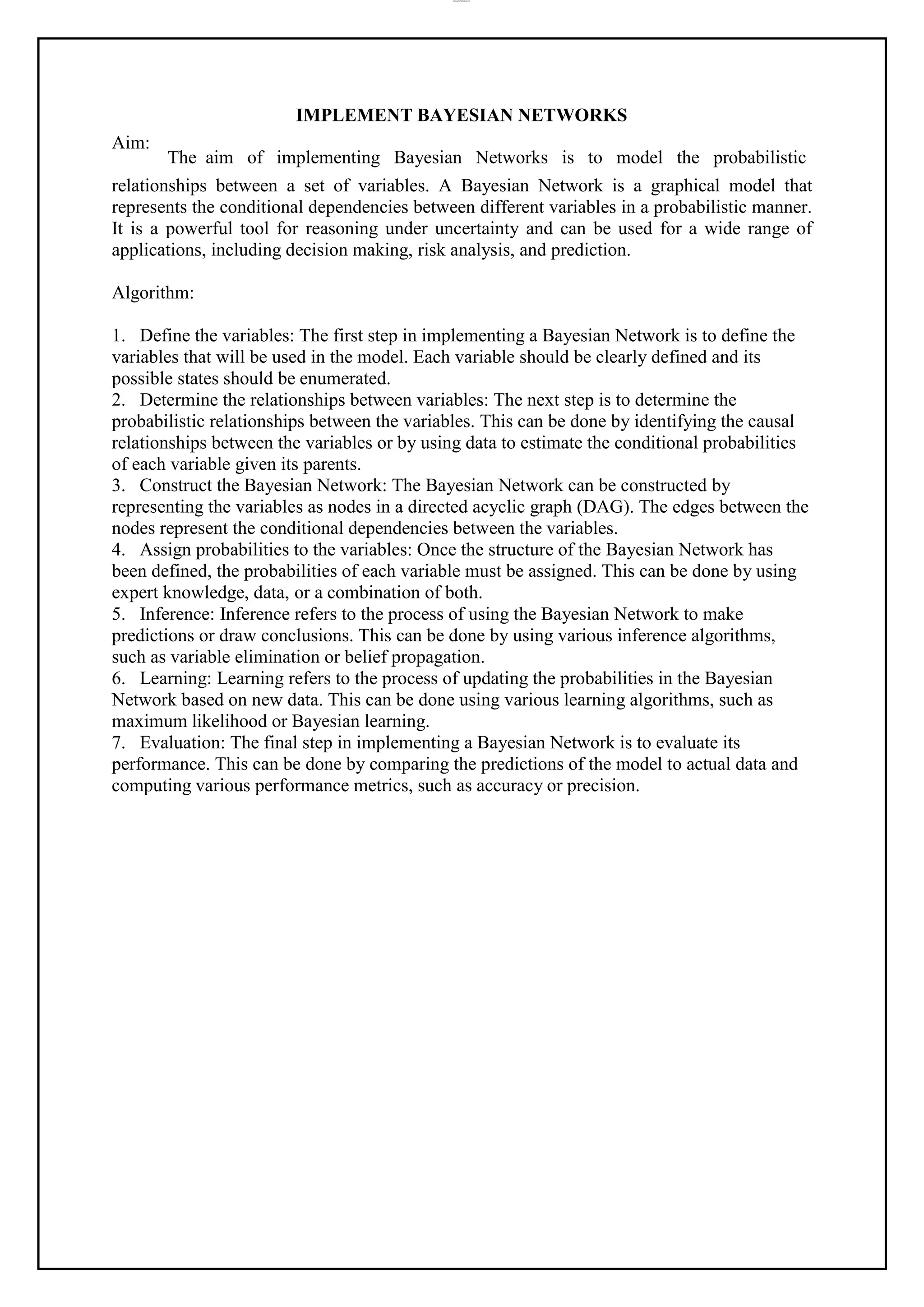
![lOMoAR cPSD|37458118
Program:
Import numpy as np
import csv
import pandas as pd
from pgmpy.models import BayesianModel
from pgmpy.estimators import MaximumLikelihoodEstimator
from pgmpy.inference import VariableElimination
#read Cleveland Heart Disease data
heartDisease = pd.read_csv('heart.csv')
heartDisease = heartDisease.replace('?',np.nan)
#display the data
print('Few examples from the dataset are given below')
print(heartDisease.head())
#Model Bayesian Network
Model=BayesianModel([('age','trestbps'),('age','fbs'),
('sex','trestbps'),('exang','trestbps'),('trestbps','heartdise
ase'),('fbs','heartdisease'),('heartdisease','restecg'),
('heartdisease','thalach'),('heartdisease','chol')])
#Learning CPDs using Maximum Likelihood Estimators
print('n Learning CPD using Maximum likelihood estimators')
model.fit(heartDisease,estimator=MaximumLikelihoodEstimator)
# Inferencing with Bayesian Network
print('n Inferencing with Bayesian Network:')
HeartDisease_infer = VariableElimination(model)
#computing the Probability of HeartDisease given Age
print('n 1. Probability of HeartDisease given Age=30')
q=HeartDisease_infer.query(variables=['heartdisease'],evidence
={'age':28})
print(q['heartdisease'])
#computing the Probability of HeartDisease given cholesterol
print('n 2. Probability of HeartDisease given cholesterol=100')
q=HeartDisease_infer.query(variables=['heartdisease'],evidence
={'chol':100})
print(q['heartdisease'])](https://image.slidesharecdn.com/cs3491-aiandmllabmanual-240329185501-79b0d618/75/CS3491-AI-and-ML-lab-manual-cs3491-r2021-18-2048.jpg)
![lOMoAR cPSD|37458118
Output:
age sex cptrestbps ...slope cathalheartdisease
0 63 1 1 145 ... 3 0 6 0
1 67 1 4 160 ... 2 3 3 2
2 67 1 4 120 ... 2 2 7 1
3 37 1 3 130 ... 3 0 3 0
4 41 0 2 130 ... 1 0 3 0
[5 rows x 14 columns]
Learning CPD using Maximum likelihood estimators
Inferencing with Bayesian Network:
1. Probability of HeartDisease given Age=28
╒════════════════╤═════════════════════╕
│ heartdisease │ phi(heartdisease) │
╞════════════════╪═════════════════════╡
│ heartdisease_0 │ 0.6791 │
├────────────────┼─────────────────────┤
│ heartdisease_1 │ 0.1212 │
├────────────────┼─────────────────────┤
│ heartdisease_2 │ 0.0810 │
├────────────────┼─────────────────────┤
│ heartdisease_3 │ 0.0939 │
├────────────────┼─────────────────────┤
│ heartdisease_4 │ 0.0247 │
╘════════════════╧═════════════════════╛
2. Probability of HeartDisease given cholesterol=100
╒════════════════╤═════════════════════╕
│ heartdisease │ phi(heartdisease) │
╞════════════════╪═════════════════════╡
│ heartdisease_0 │ 0.5400 │
├────────────────┼─────────────────────┤
│ heartdisease_1 │ 0.1533 │
├────────────────┼─────────────────────┤
│ heartdisease_2 │ 0.1303 │
├────────────────┼─────────────────────┤
│ heartdisease_3 │ 0.1259 │
├────────────────┼─────────────────────┤
│ heartdisease_4 │ 0.0506 │
╘════════════════╧═════════════════════╛
Result:
Thus the program is executed successfully and output is verified.](https://image.slidesharecdn.com/cs3491-aiandmllabmanual-240329185501-79b0d618/75/CS3491-AI-and-ML-lab-manual-cs3491-r2021-19-2048.jpg)

![lOMoAR cPSD|37458118
Program:
import pandas as pd
importnumpy as np
importmatplotlib.pyplot as plt
fromsklearn.linear_model import LinearRegression
fromsklearn.model_selection import train_test_split
fromsklearn.metrics import mean_squared_error, r2_score
# Load the dataset
df = pd.read_csv('dataset.csv')
# Split the dataset into training and testing sets
X = df[['feature1', 'feature2', ...]]
y = df['target']
X_train, X_test, y_train, y_test = train_test_split(X, y, test_size=0.2, random_state=42)
# Train the regression model
reg = LinearRegression()
reg.fit(X_train, y_train)
# Make predictions on the test set
y_pred = reg.predict(X_test)
# Evaluate the model
print('Mean squared error: %.2f' % mean_squared_error(y_test, y_pred))
print('Coefficient of determination: %.2f' % r2_score(y_test, y_pred))
# Plot the results
plt.scatter(X_test['feature1'], y_test, color='black')
plt.plot(X_test['feature1'], y_pred, color='blue', linewidth=3)
plt.xticks(())
plt.yticks(())
plt.show()](https://image.slidesharecdn.com/cs3491-aiandmllabmanual-240329185501-79b0d618/75/CS3491-AI-and-ML-lab-manual-cs3491-r2021-21-2048.jpg)
![lOMoAR cPSD|37458118
Out Put:
Coefficients: [ 0.19246454 -0.07720843 0.02463994]
Mean squared error: 18.10
Coefficient of determination: 0.87
Result:
Thus the program for build regression models is executed successfully and output is
verified.](https://image.slidesharecdn.com/cs3491-aiandmllabmanual-240329185501-79b0d618/75/CS3491-AI-and-ML-lab-manual-cs3491-r2021-22-2048.jpg)

![lOMoAR cPSD|37458118
Program:
import pandas as pd
fromsklearn.tree import DecisionTreeRegressor
fromsklearn.ensemble import RandomForestRegressor
fromsklearn.model_selection import train_test_split
fromsklearn.metrics import mean_squared_error
# Load data
data = pd.read_csv('data.csv')
# Split data into training and test sets
X = data.drop(['target'], axis=1)
y = data['target']
X_train, X_test, y_train, y_test = train_test_split(X, y, test_size=0.2, random_state=42)
# Build decision tree
dt = DecisionTreeRegressor()
dt.fit(X_train, y_train)
# Predict on test set
y_pred = dt.predict(X_test)
# Evaluate performance
mse = mean_squared_error(y_test, y_pred)
print(f"Decision Tree Mean Squared Error: {mse:.4f}")
# Build random forest
rf = RandomForestRegressor()
rf.fit(X_train, y_train)
# Predict on test set
y_pred = rf.predict(X_test)
# Evaluate performance
mse = mean_squared_error(y_test, y_pred)
print(f"Random Forest Mean Squared Error: {mse:.4f}")](https://image.slidesharecdn.com/cs3491-aiandmllabmanual-240329185501-79b0d618/75/CS3491-AI-and-ML-lab-manual-cs3491-r2021-24-2048.jpg)

![lOMoAR cPSD|37458118
SVC
Aim:
BUILD SVM MODELS
The aim of this Python code is to demonstrate how to use the scikit-learn library to
train support vector machine (SVM) models for classification tasks.
Algorithm:
1. Load a dataset using the pandas library
2. Split the dataset into training and testing sets using
scikit-learn
function from
3. Train three SVM models with different kernels (linear, polynomial, and RBF) using
function from scikit-learn
4. Predict the test set labels using the trained models
5. Evaluate the accuracy of the models using the
learn
6. Print the accuracy of each model
Program:
import pandas as pd
fromsklearn.model_selection import train_test_split
fromsklearn.svm import SVC
fromsklearn.metrics import accuracy_score
# Load the dataset
data = pd.read_csv('data.csv')
function from scikit-
# Split the data into training and testing sets
X_train, X_test, y_train, y_test = train_test_split(data.drop('target', axis=1), data['target'],
test_size=0.3, random_state=42)
# Train an SVM model with a linear kernel
svm_linear = SVC(kernel='linear')
svm_linear.fit(X_train, y_train)
# Predict the test set labels
y_pred = svm_linear.predict(X_test)
# Evaluate the model's accuracy
accuracy = accuracy_score(y_test, y_pred)
print(f'Linear SVM accuracy: {accuracy:.2f}')
# Train an SVM model with a polynomial kernel
svm_poly = SVC(kernel='poly', degree=3)
svm_poly.fit(X_train, y_train)
# Predict the test set labels
y_pred = svm_poly.predict(X_test)
# Evaluate the model's accuracy
accuracy = accuracy_score(y_test, y_pred)
print(f'Polynomial SVM accuracy: {accuracy:.2f}')
accuracy_score
train_test_split](https://image.slidesharecdn.com/cs3491-aiandmllabmanual-240329185501-79b0d618/75/CS3491-AI-and-ML-lab-manual-cs3491-r2021-26-2048.jpg)
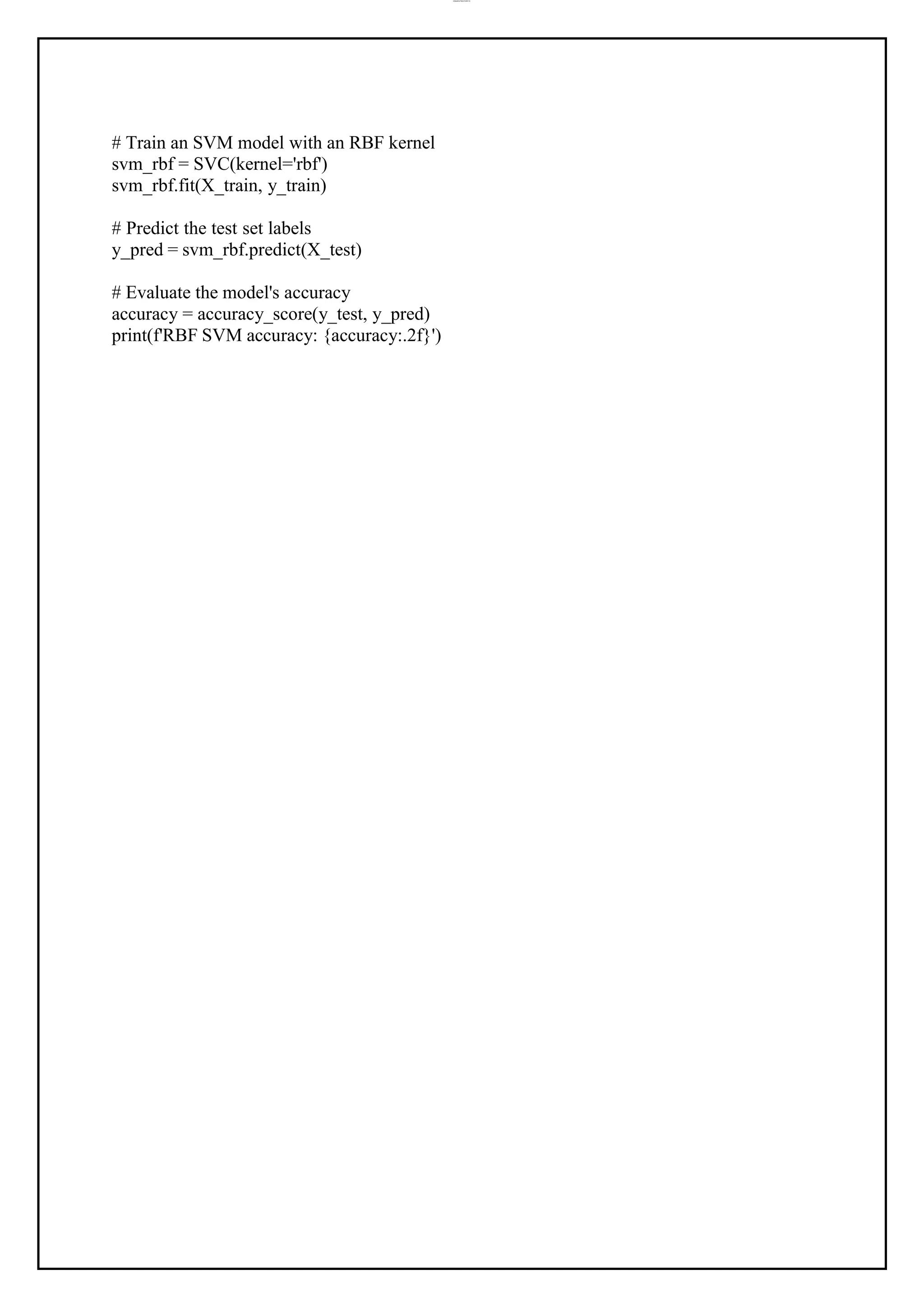


![lOMoAR cPSD|37458118
Program:
# import required libraries
fromsklearn import datasets
fromsklearn.model_selection import train_test_split
fromsklearn.ensemble import RandomForestClassifier, VotingClassifier
fromsklearn.svm import SVC
fromsklearn.linear_model import LogisticRegression
# load sample dataset
iris = datasets.load_iris()
# split dataset into training and testing sets
X_train, X_test, y_train, y_test = train_test_split(iris.data, iris.target, test_size=0.3)
# build individual models
svc_model = SVC(kernel='linear', probability=True)
rf_model = RandomForestClassifier(n_estimators=10)
lr_model = LogisticRegression()
# create ensemble model
ensemble = VotingClassifier(estimators=[('svc', svc_model), ('rf', rf_model), ('lr', lr_model)],
voting='soft')
# train ensemble model
ensemble.fit(X_train, y_train)
# make predictions on test set
y_pred = ensemble.predict(X_test)
# print ensemble model accuracy
print("Ensemble Accuracy:", ensemble.score(X_test, y_test))](https://image.slidesharecdn.com/cs3491-aiandmllabmanual-240329185501-79b0d618/75/CS3491-AI-and-ML-lab-manual-cs3491-r2021-30-2048.jpg)


![lOMoAR cPSD|37458118
Program:
from sklearn.datasets import make_blobs
from sklearn.cluster import KMeans, AgglomerativeClustering
import matplotlib.pyplot as plt
# Generate a random dataset with 100 samples and 4 clusters
X, y = make_blobs(n_samples=100, centers=4, random_state=42)
# Create a K-Means clustering object with 4 clusters
kmeans = KMeans(n_clusters=4, random_state=42)
# Fit the K-Means model to the dataset
kmeans.fit(X)
# Create a scatter plot of the data colored by K-Means cluster assignment
plt.scatter(X[:, 0], X[:, 1], c=kmeans.labels_)
plt.title("K-Means Clustering")
plt.show()
# Create a Hierarchical clustering object with 4 clusters
hierarchical = AgglomerativeClustering(n_clusters=4)
# Fit the Hierarchical model to the dataset
hierarchical.fit(X)
# Create a scatter plot of the data colored by Hierarchical cluster assignment
plt.scatter(X[:, 0], X[:, 1], c=hierarchical.labels_)
plt.title("Hierarchical Clustering")
plt.show()](https://image.slidesharecdn.com/cs3491-aiandmllabmanual-240329185501-79b0d618/75/CS3491-AI-and-ML-lab-manual-cs3491-r2021-33-2048.jpg)
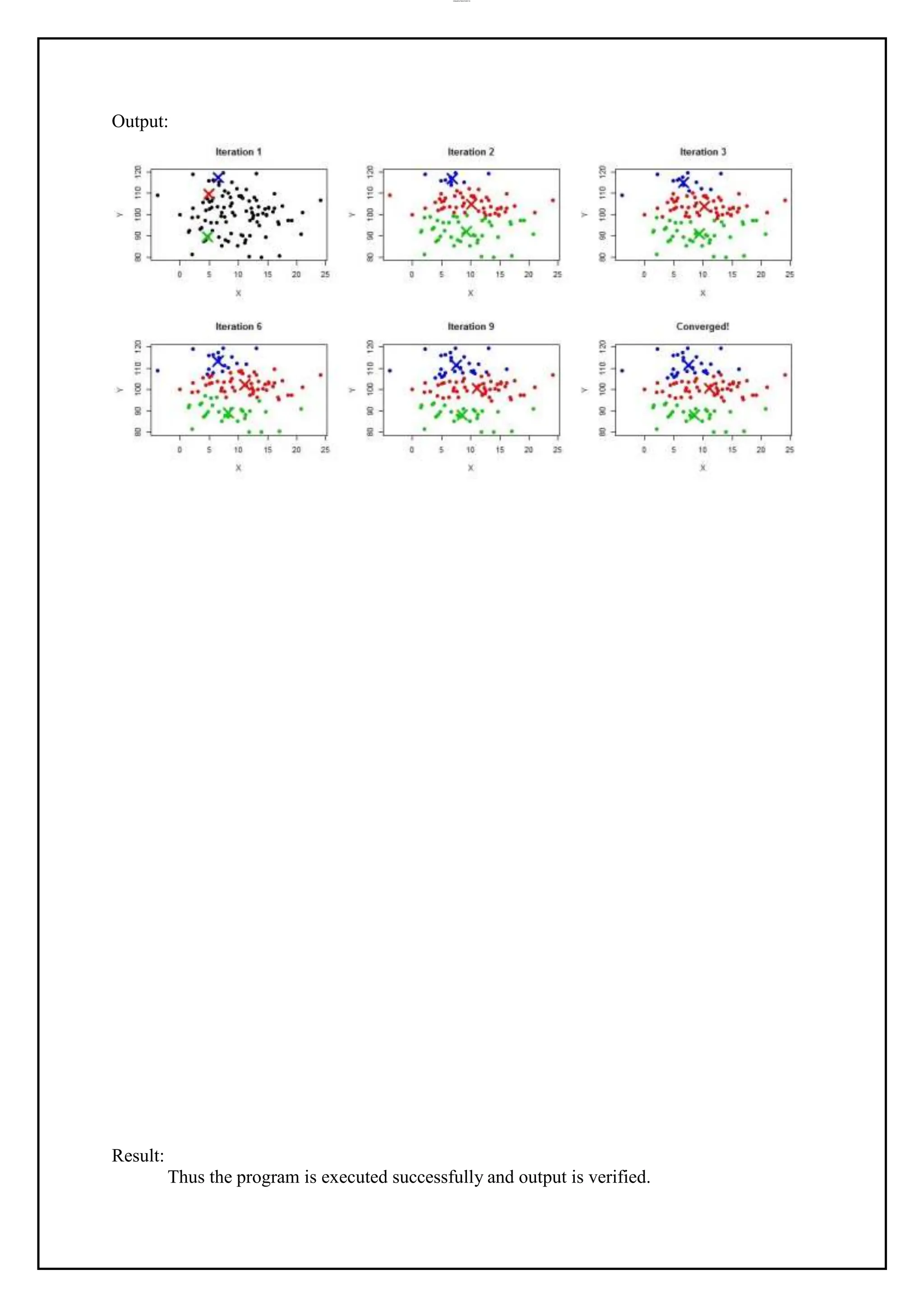
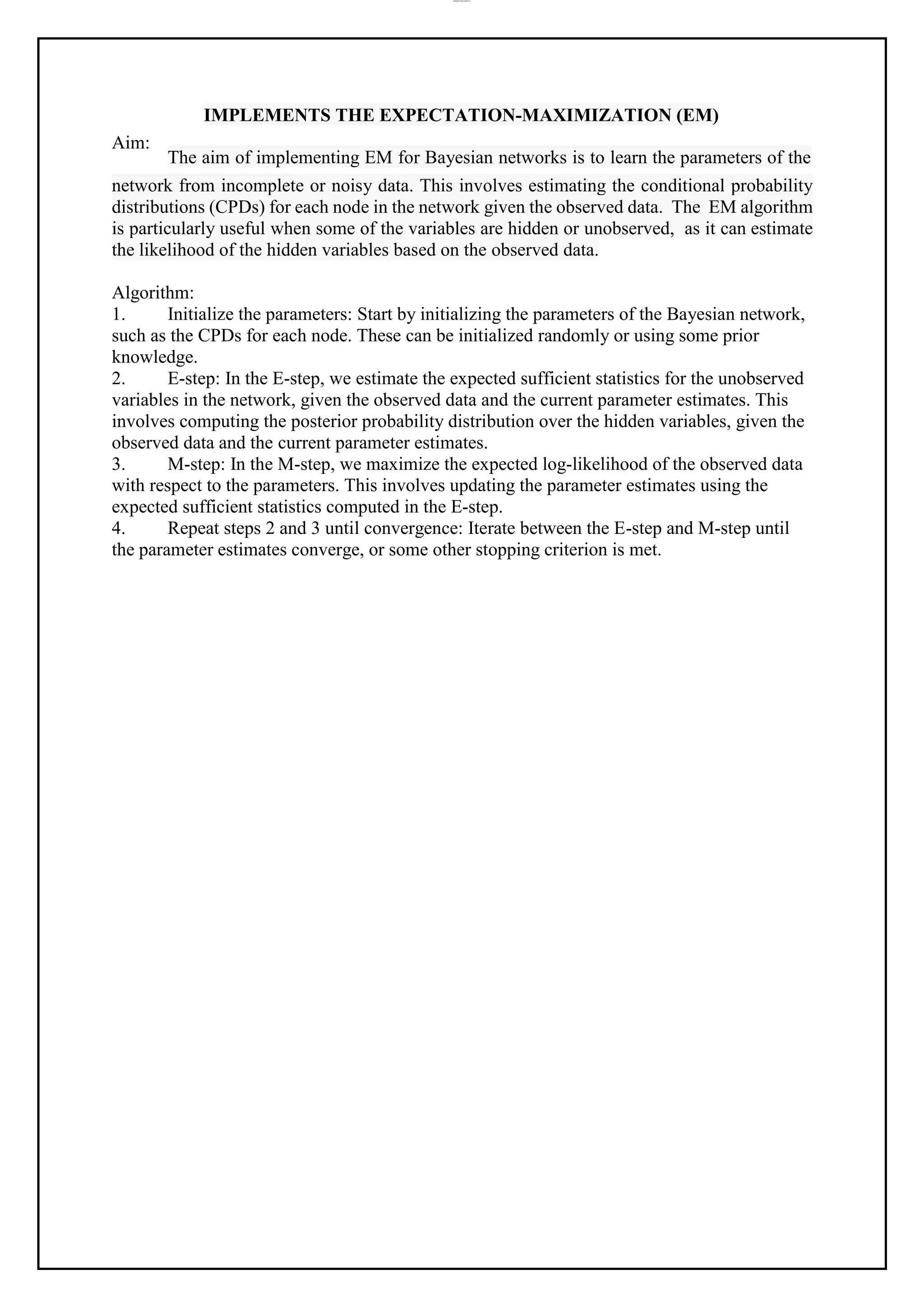
![lOMoAR cPSD|37458118
Program:
from pgmpy.models import BayesianModel
from pgmpy.estimators import MaximumLikelihoodEstimator
from pgmpy.inference import VariableElimination
from pgmpy.factors.discrete import TabularCPD
import numpy as np
# Define the structure of the Bayesian network
model = BayesianModel([('C', 'S'), ('D', 'S')])
# Define the conditional probability distributions (CPDs)
cpd_c = TabularCPD('C', 2, [[0.5], [0.5]])
cpd_d = TabularCPD('D', 2, [[0.5], [0.5]])
cpd_s = TabularCPD('S', 2, [[0.8, 0.6, 0.6, 0.2], [0.2, 0.4, 0.4, 0.8]],
evidence=['C', 'D'], evidence_card=[2, 2])
# Add the CPDs to the model
model.add_cpds(cpd_c, cpd_d, cpd_s)
# Create a Maximum Likelihood Estimator and fit the model to some data
data = np.random.randint(low=0, high=2, size=(5000, 2))
mle = MaximumLikelihoodEstimator(model, data)
model_fit = mle.fit()
# Create a Variable Elimination object to perform inference
infer = VariableElimination(model)
# Perform inference on some observed evidence
query = infer.query(['S'], evidence={'C': 1})
print(query)](https://image.slidesharecdn.com/cs3491-aiandmllabmanual-240329185501-79b0d618/75/CS3491-AI-and-ML-lab-manual-cs3491-r2021-36-2048.jpg)
![lOMoAR cPSD|37458118
Output:
Finding Elimination Order: : 100%|██████████| 1/1 [00:00<00:00, 336.84it/s]
Eliminating: D: 100%|██████████| 1/1 [00:00<00:00, 251.66it/s]
+ + +
| S | phi(S) |
+=====+==========+
| S_0 | 0.6596 |
+-----+----------+
| S_1 | 0.3404 |
+-----+----------+
Result:
Thus the program is executed successfully and output is verified.](https://image.slidesharecdn.com/cs3491-aiandmllabmanual-240329185501-79b0d618/75/CS3491-AI-and-ML-lab-manual-cs3491-r2021-37-2048.jpg)

![lOMoAR cPSD|37458118
Program:
import tensorflow as tf
from tensorflow import keras
# Load the MNIST dataset
(x_train, y_train), (x_test, y_test) = keras.datasets.mnist.load_data()
# Normalize the input data
x_train = x_train / 255.0
x_test = x_test / 255.0
# Define the model architecture
model = keras.Sequential([
keras.layers.Flatten(input_shape=(28, 28)),
keras.layers.Dense(128, activation='relu'),
keras.layers.Dense(10, activation='softmax')
])
# Compile the model
model.compile(optimizer='adam',
loss='sparse_categorical_crossentropy',
metrics=['accuracy'])
# Train the model
model.fit(x_train, y_train, epochs=10, validation_data=(x_test, y_test))
# Evaluate the model
test_loss, test_acc = model.evaluate(x_test, y_test, verbose=2)
print('Test accuracy:', test_acc)](https://image.slidesharecdn.com/cs3491-aiandmllabmanual-240329185501-79b0d618/75/CS3491-AI-and-ML-lab-manual-cs3491-r2021-39-2048.jpg)
![lOMoAR cPSD|37458118
Output:
Epoch 1/10
1875/1875 [==============================] - 2s 1ms/step - loss: 0.2616 -
accuracy: 0.9250 - val_loss: 0.1422 - val_accuracy: 0.9571
Epoch 2/10
1875/1875 [==============================] - 2s 1ms/step - loss: 0.1159 -
accuracy: 0.9661 - val_loss: 0.1051 - val_accuracy: 0.9684
Epoch 3/10
1875/1875 [==============================] - 2s 1ms/step - loss: 0.0791 -
accuracy: 0.9770 - val_loss: 0.0831 - val_accuracy: 0.9741
Epoch 4/10
1875/1875 [==============================] - 2s 1ms/step - loss: 0.0590 -
accuracy: 0.9826 - val_loss: 0.0807 - val_accuracy: 0.9754
Epoch 5/10
1875/1875 [==============================] - 2s 1ms/step - loss: 0.0462 -
accuracy: 0.9862 - val_loss: 0.0751 - val_accuracy: 0.9774
Epoch 6/10
1875/1875 [==============================] - 2s 1ms/step - loss: 0.0366 -
accuracy: 0.9892 - val_loss: 0.0742 - val_accuracy: 0.9778
Epoch 7/10
1875/1875 [==============================] - 2s 1ms/step - loss: 0.0288 -
accuracy: 0.9916 - val_loss: 0.0726 - val_accuracy: 0.9785
Epoch 8/10
1875/1875 [==============================] - 2s 1ms/step - loss: 0.0240 -
accuracy: 0.9931 - val_loss: 0.0816 - val_accuracy: 0.9766
Epoch 9/10
1875/1875 [==============================] - 2s 1ms/step - loss: 0.0192 -
accuracy: 0.9948 - val_loss: 0.0747 - val_accuracy: 0.9783
Epoch 10/10
1875/187
Result:
Thus the program is executed successfully and output is verified.](https://image.slidesharecdn.com/cs3491-aiandmllabmanual-240329185501-79b0d618/75/CS3491-AI-and-ML-lab-manual-cs3491-r2021-40-2048.jpg)
![lOMoAR cPSD|37458118
BUILD DEEP LEARNING NN MODELS
Aim:
The aim of building deep learning neural network (NN) models is to create a more complex
architecture that can learn hierarchical representations of data, allowing for more accurate predictions and
better generalization to new data. Deep learning models are typicallycharacterized by having many layers
and a large number of parameters.
Algorithm:
1. Data preparation: Preprocess the data to make it suitable for training the NN. This
may involve normalizing the input data, splitting the data into training and validation sets,
and encoding the output variables if necessary.
2. Define the architecture: Choose the number of layers and neurons in the NN, and
define the activation functions for each layer. Deep learning models typically use activation
functions such as ReLU or variants thereof, and often incorporate dropout or other
regularization techniques to prevent overfitting.
3. Initialize the weights: Initialize the weights of the NN randomly, using a small value
to avoid saturating the activation functions.
4. Forward propagation: Feed the input data forward through the NN, applying the
activation functions at each layer, and compute the output of the NN.
5. Compute the loss: Calculate the error between the predicted output and the true
output, using a suitable loss function such as mean squared error or cross-entropy.
6. Backward propagation: Compute the gradient of the loss with respect to the weights,
using the chain rule and backpropagate the error through the NN to adjust the weights.
7. Update the weights: Adjust the weights using an optimization algorithm such as
stochastic gradient descent or Adam, and repeat steps 4-7 for a fixed number of epochs or
until the performance on the validation set stops improving.
8. Evaluate the model: Test the performance of the model on a held-out test set and
report the accuracy or other performance metrics.
9. Fine-tune the model: If necessary, fine-tune the model by adjusting the
hyperparameters or experimenting with different architectures.
Program:
import tensorflow as tf
from tensorflow import keras
# Load the MNIST dataset
(x_train, y_train), (x_test, y_test) = keras.datasets.mnist.load_data()
# Normalize the input data
x_train = x_train / 255.0
x_test = x_test / 255.0
# Define the model architecture
model = keras.Sequential([
keras.layers.Flatten(input_shape=(28, 28)),
keras.layers.Dense(128, activation='relu'),
keras.layers.Dropout(0.2),
keras.layers.Dense(10)
])
# Compile the model
model.compile(optimizer='adam',
loss=tf.keras.losses.SparseCategoricalCrossentropy(from_logits=True),](https://image.slidesharecdn.com/cs3491-aiandmllabmanual-240329185501-79b0d618/75/CS3491-AI-and-ML-lab-manual-cs3491-r2021-41-2048.jpg)
![lOMoAR cPSD|37458118
metrics=['accuracy'])
# Train the model
model.fit(x_train, y_train, epochs=10, validation_data=(x_test, y_test))
# Evaluate the model
test_loss, test_acc = model.evaluate(x_test, y_test, verbose=2)
print('Test accuracy:', test_acc)](https://image.slidesharecdn.com/cs3491-aiandmllabmanual-240329185501-79b0d618/75/CS3491-AI-and-ML-lab-manual-cs3491-r2021-42-2048.jpg)
![lOMoAR cPSD|37458118
Output:
Epoch 1/10
1875/1875 [==============================] - 2s 1ms/step - loss: 0.2921 -
accuracy: 0.9148 - val_loss: 0.1429 - val_accuracy: 0.9562
Epoch 2/10
1875/1875 [==============================] - 2s 1ms/step - loss: 0.1417 -
accuracy: 0.9577 - val_loss: 0.1037 - val_accuracy: 0.9695
Epoch 3/10
1875/1875 [==============================] - 2s 1ms/step - loss: 0.1066 -
accuracy: 0.9676 - val_loss: 0.0877 - val_accuracy: 0.9724
Epoch 4/10
1875/1875 [==============================] - 2s 1ms/step - loss: 0.0855 -
accuracy: 0.9730 - val_loss: 0.0826 - val_accuracy: 0.9745
Epoch 5/10
1875/1875 [==============================] - 2s 1ms/step - loss: 0.0732 -
accuracy: 0.9772 - val_loss: 0.0764 - val_accuracy: 0.9766
Epoch 6/10
1875/1875 [==============================] - 2s 1ms/step - loss: 0.0635 -
accuracy: 0.9795 - val_loss: 0.0722 - val_accuracy: 0.9778
Epoch 7/10
1875/1875 [==============================] - 2s 1ms/step - loss: 0.0551 -
accuracy: 0.9819 - val_loss: 0.0733 - val_accuracy: 0.9781
Epoch 8/10
1875/1875 [==============================] - 2s 1ms/step - loss: 0.0504 -
accuracy: 0.9829 - val_loss: 0.0714 - val_accuracy: 0.9776
Epoch 9/10
1875/1875 [==============================] - 2s 1ms/step - loss: 0.0460 -
accuracy: 0.9847 - val_loss: 0.0731 - val_accuracy:
Result:
Thus the program is executed successfully and output is verified.](https://image.slidesharecdn.com/cs3491-aiandmllabmanual-240329185501-79b0d618/75/CS3491-AI-and-ML-lab-manual-cs3491-r2021-43-2048.jpg)